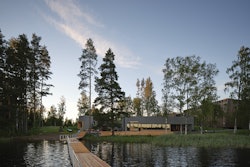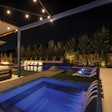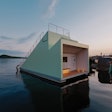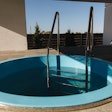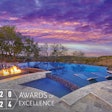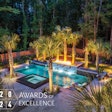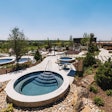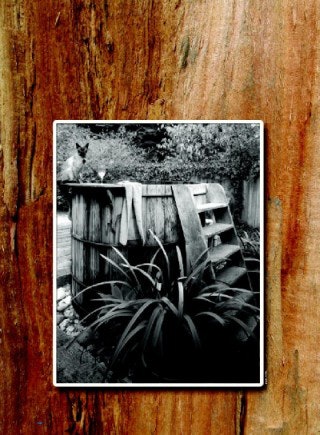
The magic happens at the waterline. Above it are the spent efforts of an average working day. But as the body descends, slides down, and crosses the waterline, the petty injuries and small claims of life dissolve.
As if by corrective lenses, we can now see more clearly the faces around us, where we are, what is real.
We didn't invent that. But as a group, we've brought the magic to people who either couldn't afford it or didn't know it could be invoked, conveniently, on a regular basis.
That is the story of the American spa industry.
Root And Branch
We could start with the Romans, in northern Gaul, in the crowded caldarium of the small frontier town of Spa. Or we could begin further back with the Greeks, or look to the Far East — nearly every culture with a recorded history speaks of a love for the hot soak.
But this is a quest for the origins and upbringing of the American spa. Where are its roots. Where, in the dark loam of the past, lie the tendrils that grew into this thriving stand of American culture and industry?
One branch of the root system certainly comes from the wooden hot tub business; as early as the '50s, and probably before, Californians in the winegrowing region were taking old wine vats, tanks and barrels, filling them with hot water — even placing them under a hot spring for more action — and sharing the intimate experience with friends.
It was something like a modern spa.
Elsewhere in California, the Jacuzzi family was busy inventing pumps and jets and putting them in tubs as early as 1956. And later, in 1968, Roy Jacuzzi invented the first self-contained whirlpool bath.
And that was something like a modern spa.
Meanwhile, in a related industry, more and more customers were pleasantly surprised at the enjoyment they found in a small addendum to their swimming pool. It was almost an afterthought — a tiny bubbling body of hot water next to the main attraction — but it was amazingly popular; at times even more so than the headliner it was intended to augment.
It, too, was very much like a modern spa, except it only had the one jet. And for some reason, the broad populace could only envision it next to a swimming pool. It was as inconceivable as a stand-alone product in the 1960s as a wireless telephone.
So there were flower children getting back to nature in wooden tubs up in the hills, upper-class suburbanites chatting in gunite spas in the Valley, and hydrotherapy and relaxation pumping through Roy Jacuzzi's jetted tubs. And then, right about 1970, things started coming together.
These elements and the contributions of many others would coalesce into a recognizable product and industry. The consumer demand was there, even if the consumers themselves didn't know it. (The desire for a bubbling, self-contained soak is built into us.) But to make that desire into an industry, the spa experience itself was going to have to get better, faster and easier.
As offered, in 1970, there were impediments:
The wooden tubs tended to be somewhat leaky, and had no jets, per se. There were also some endemic limits to growth in this segment of the market. That's another way of saying the people who made them often wanted to soak in them, too, and if they were having a good time, might very well blow-off a business meeting or two.
Jetted tubs were fine, but they had to be refilled, which was costly, and seating was limited.
And gunite spas attached to swimming pools were expensive to build. They were expensive because they were not mass-produced. Each and every one was as unique as a handblown vase, and even more labor intensive.
Minds were at work on these problems, however. Innovation was just around the corner. Abstract ideas would become hard components, as the modern product began to take shape and more consumers gained access to the magic of the spa experience.
If Everything Went Well . . .
By 1970, the backyard gunite spa was growing in popularity as a pool fashion accessory of the well-to-do. It was a costly accessory, due to the fact that every gunite spa was built by hand, from the ground up. Sequentially. By different craftsmen.
One guy came on Tuesday to dig the hole. The next guy was supposed to come on Thursday to construct the gunite shell, but he called in sick. The plumber showed up on Friday as scheduled, looked at the empty hole, and went home.
"If everything went well, the whole thing would take at least two weeks. But let me emphasize, that's if everything went really well ," says Bernie Burba, Baja Products, Tucson, Ariz., whose professional experience spans 50 years in the pool and spa industry.
Product growth was being strangled by production methods. At least those were the thoughts of Len Gordon, a Southern California contractor. Gordon would later become a legend in the spa industry for his inquisitive, innovative mind, but in 1969 he was just trying to make poolside spa installation easier.
Almost half of the pools Gordon built had attached gunite spas, Gordon told Spa and Sauna (the magazine that would eventually become AQUA), in 1986, "and building gunite spas with any real consistency was a very difficult thing to do."
As Gordon pondered the problem, his friend Jack Stangle had begun to wonder if a spa would work as well if it were made of fiberglass. It seemed to him that it would be easier to make that way. Gordon was an idea man, and when he had one, he was relentless in pursuit. Always a daring entrepreneur, he jumped into the spa manufacturing business with both feet.
He rented some space at a nearby gas station, and started making fiberglass spas. These first, "mass-produced" spas were built using a mold. The builder would spray a non-stick, separating agent into the mold (the manufacturing equivalent of Pam), followed with gel-coat, and then fiberglass for structural strength. Pop it out, and it's a spa.
These prefabricated spa shells changed the equation entirely. First Gordon's spa builders started using them. Then everybody started using them.
"The fiberglass shell was a contractor's dream," Gordon said later. "All you had to do was dig a hole in the ground and you were just about finished. It cut the costs dramatically over gunite."
There were some doubts at first among consumers; people weren't used to the feel of the product and didn't know how it would last. But the price was irresistible. "Everybody fell in love with it because it was something the blue-collar worker could now afford," said Gordon.
Wine Barrels, Bohemians
While Len Gordon was celebrating down in Los Angeles, elsewhere in California, a cottage industry was putting bodies into wooden barrels, one at a time.
In the 1960s, the first wooden hot tubs began to appear in numbers in California. These early prototypes, inspired by the traditional Japanese ofuro bathing tubs, were made using leftover materials from nearby wineries of the region.
As the popularity of the wooden tubs grew, people went into business.
The wooden tub experience was different, right from the start. Wooden hot tubs were sold to fun-loving Bohemians. They were sold by fun-loving Bohemians — people who might sell a tub and be over to party in it later in the week.
Gary Gordon started a wooden tub business, and runs one to this day, although wooden hot tubs are now a small part of his business. He's the owner of Gordon and Grant Hot Tubs and Spas, Santa Barbara, Calif.
But back then he was a young man looking for fun. And the action in Santa Barbara — the bubbling water, etc. — was up on Mountain Drive. "It was a wild place back then. People were up there making wine —just for themselves, you understand — and they were stompin' grapes and partying. It was nuts up there.
"People were partying in these old wine vats or even pickle barrels. There were small ones, mediumsized ones, even giant ones, with 20 to 30 people in them. It was big and open and there were no seats or lounges, nothing in the way. It was just pure hot water enjoyment."
Gordon and his buddy Richard Grant had to have one. And then their friends had to have one. And one day they looked around and realized they were in business (see sidebar on page 86). And business was good.
And it stayed good. At one point, the partners had 18 employees cutting boards and putting kits together.
Throughout the '70s, wooden tubs held onto a hefty share of the market, and supported 15 to 20 manufacturers. Within the low cost, "portable" spa market, the wooden tubs were better known than fiberglass or acrylic. But these other segments were growing rapidly, helped by the innovations of Roy Jacuzzi.
The Jacuzzi Brothers
Converging on the modern spa from a completely different angle were the jetted bathtubs from the Jacuzzi brothers. The Jacuzzis had come to the U.S. in the early 1900s, bringing with them a good understanding of hydraulics and fluid dynamics and a strong entrepreneurial spirit.
Like Gordon, they were inventors. They are credited with the first enclosed monoplane, and their pump designs found application in the aviation and agriculture industries, but it was a necessity caused by a family illness that proved to be the mother of the first hydrotherapy tub, in 1956.
A small child, a member of the Jacuzzi family, had been stricken with arthritis, and was receiving hydrotherapy treatment at a medical facility in Berkeley, Calif. The trouble was that the family lived in Walnut Grove, 65 miles away over pre-interstate roads and lanes. The trip took hours, says Jonathan Clark, president of Jacuzzi Hot Tubs and Sundance Spas.
The hydrotherapy unit in Berkeley was a big, fancy medical machine that pumped warm water over the arthritic limb. The brothers knew pumps . . .why not make a portable, submersible one for the child's bathtub at home?
There and then, the concept for the J-300 portable hydrotherapy pump was born. It could turn any bathtub into a relaxing spa-like atmosphere at the flip of a switch.
"It used to be a prize on the gameshows in the '60s, as a promotion. You would simply drop the pump right into the tub," says Clark.
Later, in 1968, Roy Jacuzzi brought the portable hydrotherapy pump to the next level with the invention of the modern whirlpool bath, which he dubbed, in honor of the greatest tubbing society of all time, "the Roman."
It had 50/50 air-to-water ratio jets, and fully integrated plumbing.
"And In 1970," says Clark, "Roy Jacuzzi took a pump along with a motor, heaters and a filtration system in a self-contained vessel, and invented pretty much what we would call the modern portable spa. And to this day, many people still call a spa or a hot tub a Jacuzzi, because it was invented by this family.
"Many people know that Roy Jacuzzi revolutionized the bath industry when he invented the jetted tub, but the story very few people know is that Roy Jacuzzi also revolutionized the hot tub industry."
The '70s – The Spa Rush
People invent new products and start new businesses every day. Ninetynine percent of them become humorous family stories. But the initiatives in the infant spa industry caught the public eye.
At the dawn of the '70s, the public was starting to understand that a new product could dramatically alter and improve an experience they already knew they liked — a relaxing bath.
"It was a great time," recalls Henry Young, president, Aqua Nova, Van Nuys, Calif., a man whose pool and spa industry memories go back to the mid-'60s. "You had guys drilling holes in the seats of spas, putting air blowers under them and selling rides for a quarter. It was an exciting time."
Spas were the hot new thing coming out of California — still the great golden draw for most Americans. It was a sexy product from a place a lot of people wanted to be.
The wooden tubs were better known, and gaining in popularity, but the real growth was in the fiberglass, gel-coat shells that were being plumbed in wherever a solid foundation could be found.
The fiberglass spa was a hot new product that was easy to sell and fairly easy to make. Anybody could make a spa mold, and once you did, you were a going concern, right there in the garage in many cases.
You didn't even have to design the mold. You could simply borrow an existing spa, make a mold from it, and start spitting out copies. This process, called "splashing," was common practice at the time. It was even legal in California until 1979.
Many reputable manufacturers set up operations at this time, but it was such a profitable, easy-entry business that less reputable ones felt invited, too. As one industry veteran of that time put it, "For some one who just wanted to make some money fast, and didn't mind cutting a few corners, the spa industry was a magnet."
By all accounts, some fairly shoddy products came on the market. One of the industry's old hands remembers trying to pick up a spa to move it and the spa simply breaking apart in his hands, the fiberglass was so thin.
And to make these shells into usable products, most spa builders were pulling pool equipment off the shelf.
"The pool industry was already established," remembers Henry Young, an equipment manufacturer in those days. "If you were a pump manufacturer, you made pool pumps. And when the spa people came and asked for a pump, that's what you gave them."
What that really meant was that a pump or a heater or a filter designed for a 20,000-gallon pool would have to fit into the plumbing of a 200-gallon spa.
Make no mistake, there were many dedicated and even brilliant craftsmen among this initial group of spa producers. At the same time, there were a lot of fly-by-night operations, too, partly because there were no regulations or uniform codes.
A lot of companies flamed up — and out — quickly in those days. One might come into a market, Young recalls, offer product at a loss, drive almost everybody out of business, and then go out of business itself.
It was this kind of business climate that really hampered the industry early on, says Philip Horvath, president of Aqua-gon, Naperville, Ill. He had a unique perspective on the scene, lodged between the manufacturer and the customer, as a distributor of pool and spa equipment since the '60s.
"What really held the industry back were customers that had trouble with their spas. Back then, product testing was usually done in the customer's backyard. And a lot of the products simply didn't work. So if a guy bought a spa and had trouble with it, that's what he'd tell his neighbor."
Probably the most notorious of the industry's struggles were the surface problems that plagued spas in the '70s and early '80s.
Clark joined the industry during this period, and remembers, "you had major problems with gel-coat — cracking, crazing, delamination, blistering. For some companies the failure rate was as high as 90 percent."
It was an industry bloodbath, with angry consumers demanding compensation, and manufacturers at a loss to cope. "A lot of companies just went broke because of the warranty problems with the fiberglass gel-coat spas," remembers Tim Ware, now president of Stenner, Jacksonville, Fla.
"The spa would still hold water after the gel-coat split and separated," adds Young, "but it was no longer a smooth surface, and there were a lot of complaints. And that's what brought acrylic spas into the picture." In point of fact, they were already there.
Acrylics Emerge
Baja Products had been making acrylic spas since 1973, and acrylics would come to dominate the industry in time, but as of the late '70s the majority of manufacturers were still cranking out fiberglass/gel-coat products. Industry giant Gerico, for instance, did not make the switch to an acrylic surface (with fiberglass backing to maintain structural rigidity) until 1980, according to Ware, a former Gerico employee.
The problem was cost. "A lot of people didn't get into acrylic right away because of the expense of buying the machines," he says. "You have to invest in large molds and vacuum-forming equipment, as opposed to just making some molds and spraying some fiberglass on it."
Even as many manufacturers began switching to acrylics, in the early '80s, surface problems arose with this material, too. After 10 years of making acrylic-surface tubs at Baja, according to Burba, they were seeing blistering problems. "The boat industry was having the same problem," he says, "and there were a lot of unhappy customers in both camps."
At this point, spas across all material lines — wooden tubs (which saw splintering problems with age), oldstyle gel-coat fiberglass tubs and acrylic tubs — were experiencing surface problems.
Maturity
And then, says Clark, "With the industry in the midst of a high failure rate, a couple of manufacturers got it right, and dramatically dropped their failure rate. These companies increased their sales dramatically in this period."
Among these were the Watkins brothers, who brought out a spa made of Rovel, a co-extruded material from Dow. At the same time, the acrylic problem was solved by the boat industry, says Burba. "They discovered that instead of using polyester resin against the acrylic, if they switched to vinyl ester resin, that would take care of the surface problem. That discovery took a spa industry that was really struggling, and gave it a big push forward."
But something more was afoot than just the solution of some material surface problems. Clark and others point to this period as a coming of age for the entire spa industry. "It was the transition from the early days, to professionally run businesses," he says.
The product had been around long enough for some of the manufacturing deadwood to drop off. The industry had begun to get organized, with trade associations and better communications. There is some disagreement among industry veterans on the precise date, but sometime in the early to mid-'80s the spa industry "grew up."
By startling coincidence, this period was accompanied by a large increase in sales. "It was the maturity of the industry that really brought the growth. Losing the fly-by-night tag," says Horvath.
"As the industry began to mature, the testing began to be done in the factory, where it really should be done. The product wasn't put out onto the street until it had been perfected."
More and more people, hundreds of thousands, were enjoying the spa experience and passing along the word to neighbors and friends. As always, this was a very effective marketing technique.
"At the same time," says Stan Chambers, 30-year industry veteran and exhibit director for the AQUA Show, "the public began to become educated on the product. Until the mid-'80s, consumers didn't really recognize differences in quality. One spa was the same as the next, and all were very price sensitive.
"As more companies began to design, manufacture, test and market more effectively, consumers became more comfortable with spending more for a spa."
The Transition To Portables: The Spa Pack
It was during this same period that the portable spa product itself matured — became a self-contained unit, more or less recognizable to our modern eyes. And a huge advance in that effort was the invention of the spa pack.
Up to that point, spa plumbing was being reinvented again and again, often times by unqualified inventors.
It was as if every time you wanted a new car, you had to go out and buy all the parts.
A dealer bought spa shells, pumps, heaters, filters, pipe, etc., from a distributor, and sent someone out to the customer's residence to plumb the spa.
The dealership might indeed have a gifted plumber on staff. Or, it might not.
Sometimes it was just plain old dad out there with a monkey wrench and steel fittings.
Ware, before his days at Gerico, sold spas directly to the customer, piecemeal. It was a common practice at the time. "We gave classes every week to show them how to plumb it," he says. "They'd dig a hole and put the fiberglass shell in the ground. They'd buy the components and either plumb it themselves or hire a contractor."
In short, a lot of people were just winging it. And given the complexity of the product, a sound installation was a roll of the dice.
"There is a learning curve with spa equipment," says Jim Brett, the man commonly credited with the invention of the spa pack, who now works for Hydro Air/ITT Industries, Brea, Calif. And all over the country, people were trying to pole-vault that learning curve. First-time pole vaulters, approaching the curve. One after another.
The really good ones might actually put all the pieces together in a watertight unit. But there's a lot more to spa plumbing than that.
Take heaters, for instance. Someone might feel pretty good about getting their heater hooked up, but what about size? "Most people didn't even know what the heck Watt density meant," says Brett, who was horrified by some of the engineering he saw in those days.
"They sure burned up a lot of heaters. There just wasn't enough flow to carry the heat away. Replacement heaters sold really well in those days."
The answer to the problem came in the form of a complete, mass-produced package of professionally designed spa componentry — the spa pack, made by Baker Hydro for HydroSpa, in 1976.
It was designed for the job. It fit under the skirt, in the space allotted for equipment. It worked. These were huge assets.
Later, the spa pack would become "convertible" — able to accommodate either 120V or 240V electrical service.
"Portables were still very small market until that point," says Brett. "HydroSpa was making the portable, and the first ones were straight 120V. After you plugged it in, you had to wait a long time for the spa to heat up. Then, when you turned on the pumps, the heater went off. And the water began to cool, because there weren't enough amps to run both the pump and the heater."
"That was a real nuisance. But with the 240V option, the spa became a much more practical to use. And portable spas really took off at that point."
This convertible flexibility offered an important practical advantage for retailers, too. Before the convertible spa pack, a retailer would have to keep a supply of 120V spas and 240V spas, and make sure the right spa went to the right house.
The impact of the equipment pack on the spa industry was enormous. It was the crucial step between a unit you build piece by piece on site, and a two-line hookup.
The Decline Of The Wooden Tubs
Even as the hard-shell spa business was finding its feet, wooden tubs were still very much in play. They had been improved with liners and better plumbing and marketing, largely by California Cooperage, now based in Rohnert Park, Calif.
The largest and best known of the wooden tub makers, California Cooperage (a cooper is a maker of barrels) began operations in 1974. If you opened up Playboy in the '70s, there was their ad with a toll free number to order a hot tub kit. They'd ship it to your home, and you could build it in your backyard.
Their tubs were very popular at resorts, and were considered quite chic.
And if you asked many, if not most consumers in the mid-'70s, to picture a hot tub, it was wooden product that came into their minds.
That was to change with astonishing speed.
There is some debate as to what killed off the wooden hot tub business, but there is no doubt that in the early '80s it suffered a rapid decline. People outside the business claimed they leaked and the wood rotted and caused disease. Wooden tub manufacturers said that was just a ploy used to sell against them.
But it was the growing convenience of the man-made shell spas that really wiped out the wooden tub trade. Customers might like the natural atmosphere that wood imparts, but only the die-hards could defy the convenience of a spa that you could roll into your house, plug in, and soak in almost immediately.
"Once the portables came in," says Gordon, "it was too easy."
To install a wooden tub, the dealer had to pour a slab, assemble the unit, run a gas line, dig the trenches, plumb the equipment. "It took us two days to do one," says Alice Cunningham, who transitioned into Watkins spas (see sidebar on page 98) from wooden tubs in the early '80s. "And as a dealer, we were in the construction business, really — building and plumbing these things. But suddenly, with the portable plastic spas, we could do four a day. We could have that spa at the customer's house in half an hour."
"They cost about the same at the time," Gordon says. "Which one would you rather sell if you were a dealer.
"That was the real demise of the hot tub. I mean, we're still here, and we still make them by hand, but the wooden portion is now only 10 percent of our business. But it's a really fun part. And there are still people who want them and just won't have plastic."
Convenience For All
People can't resist convenience. And it was convenience that ignited the hot tub industry.
Convenience converted it from primarily an in-ground, installation-focused business to an above-ground, portable-hot-tub-dominated enterprise. "It was the difference between building a cold-storage room and buying a refrigerator," says Clark.
"It changed the sale from a contract-type sale to a retail-store-type sale," says Cunningham. "It made the spa into a retail product that could be managed and stored and inventoried, delivered, and easily hooked up. And it became much easier to promote. It was a huge thing for the industry."
"You could sell it for less money and still make money," adds Ware. "And then people started putting steps and surrounds and decks and gazebos to go with it, and it was easy to market that, too. It was a good product and even better marketing."
The sales numbers bear this out exactly. "Before 1985, the majority of spas sold in America were in-ground," says Clark. "And from that point on, the market has been dominated by portable, above-ground spas."
The convenience of the portables also meant a dramatic improvement in quality control, Clark points out. "It really helped the industry, because it had been dependent on somebody else to dig a hole in order to sell a spa. And these people weren't plumbers — if a leak occurred underground, that was a real problem."
It was convenience for everyone. What took time and hassle for the dealer, took the same from the customer. An increasing number of Americans had the money to buy a tub, but time and energy were in short supply. The hassle-free soak sounded good to them.
No more home invasions of plumbers and handymen. No more waiting for days. And if they didn't like the spa where it was, they could move it.
"When companies came up with that neat little package, it made all the difference," says Ware.
The American Caldarium
In 1988, according to Clark's figures, spa sales hit an astounding peak of 280,000 units. It was the culmination of a remarkable period of growth. In the space of 20 years, the spa industry had grown from obscurity to an established position in the national culture. It was here to stay.
The issue had never been whether or not people liked soaking in hot water, preferably in a vessel large enough to accommodate their loved ones. Any Roman, sitting in any of the city's 900 public baths, surrounded by friends and family, could have answered that question correctly 2,000 years ago. But it took a 20-year conspiracy of inventors, entrepreneurs, builders, and men and women of business and manufacturing to bring that vessel into the realm of the possible for mainstreet America.
A Barrel Of Fun
The beginning of Gordon and Grant Hot Tubs and Spas, Santa Barbara, Calif. as told by Gary Gordon, owner:
I WAS HANGING OUT down at the docks back then, and one night a friend and I came back from a party up on Mountain Drive there in Santa Barbara — there were a bunch of bohemians and hippies up there — and we were all excited. At the party, we'd seen this really crude hot tub — an old wine vat or maybe it was a pickle barrel — with a 30-gallon hot water heater plumbed to it and a little pump going.
Anyway, when we got back in the car we just looked at each other and said, 'We gotta build one of these things.'
So we drew it up on a piece of paper on the way home, and the next day we started making one in the backyard using my dad's table saw. The first one leaked like a sieve, but we got better at it as time went on, making them one at a time and selling them to people we knew, playin' frisbee in between customers. I think we charged people about $300.
It was just a lot of fun back then. One of the reasons we built them was, hey, you could get naked girls in the tub! You could say, "come on over, we've got a hot tub," and they would do it!
I mean, if you had a hot tub, you were already halfway there.
Anyway, we had a VW van we used to haul the wood back to our place, and finally the roof collapsed under the weight, so we decided, "We gotta get a little shop or something"
And we rented a little shop, and we're still here.
Great Expectations
IN THE EARLY DAYS of the industry, the entrepreneurial spirit prevailed. That is, people often worked in makeshift factories, using what was at hand, and held operations together with baling wire and duct tape, ever looking forward to the day when they would make it big.
Watkins Manufacturing, Vista, Calif., is large and successful today, as is its dealer in the Seattle area, Olympic Hot Tub Company, led by Alice Cunningham. But back in 1982, they were both just getting started.
WE STARTED OFF selling the wooden tubs, and we were still selling them in '82 when I talked to a salesman from Watkins, who said, "You've got to see this."
So we drove down from Seattle to the Watkins factory outside Escondido, Calif., on a Saturday.
We were driving through the country for miles.
There were chicken feathers everywhere, as this was a huge chicken ranching district. In the distance we see this open-air shed. I said, "That's it!" And Blair, my husband, said, "Can't be."
Well, John and Jeff Watkins were in there , working. Every weekend they'd come out and make 15 spa shells. However long it took them, they'd make 15 shells.
They had their assembly line going. Each shell was on a dolly, and they'd just wheel it to the next workstation. And they had this five-gallon bucket of paint that they were dipping their thermostat bulb wells into, to coat them, so they wouldn't corrode.
They said we had to buy three spas to become an "official Watkins dealer." We said we'd think about it. And I could tell, as we drove away, that they were thinking, "That's the last we'll see of them."
We drove on back to Seattle, and on Monday we were back at our store with a brochure.
At 10:30 Monday morning, this very dignified elderly woman came in and said, "I've heard of something called 'a portable spa,' and I think if we had one of these things, our grandchildren might visit more often."
She picked up the brochure on the counter, and said, "This looks interesting." And I said, "Yes, I've just been to the Watkins factory this weekend!"
And she said, "I'll take one." I was so shocked, I said, "Are you sure?"
So we called the Watkins' by 11 and said, "OK, we'll take three spas."
We gave one to the lady, we put one on display, and we had one to sell, and that's how we got started.
The Creation Of Demand,The Spa Lifestyle
A LONGSIDE CHANGES IN the technology of spas, a change in the national character made way for the spa boom of the late '70s and 80's.
The early '70s really belonged to the turbulent '60s, a period of social unrest and experimentation in which anxiety over the Vietnam War and later, Watergate, dominated the national mood.
But in the late '70s and early '80s, a large segment of the country shed these concerns for a more carefree outlook.
Movies like Star Wars (1977), Animal House (1978) and 10 (1979) spoke to a portion of society that had definitely lost interest in social movements, and was now looking, basically, for a good time.
Spas just fit the mood. AIDS was as yet unknown. In fact, people were cautioned about the harm that might come from repressing their sexual desires. "It was, 'let's see how many naked girls we can get in the spa,'" remembers Randy Price, president, Baja Products, Tucson, Ariz.
Of course, then, as now, it was a pluralistic market. People of different ages used the product, and for completely different reasons. Some had amorous intentions, and others were just looking to get away. And even if a head of household was the only one with the means to purchase, that person was goaded by a son looking for a place to gather friends, or a wife who was desperate to relieve an aching back.
In sum, it was more complicated than some might suppose. And as time went on, the image of the spa evolved its true complexity from its initial sexy, glamorous appearance, notes Susan Kopicki, former editor of Spa and Sauna . "Even though it looked like a party product, we did surveys back in the early '80s which revealed the average buyer was 41 years old. We were surprised at that.
"They were buying something for their family to enjoy at home. Eventually you began to see it portrayed that way."
Electronics And UL
FROM THE BEGINNING, the industry was faced with the problem of an electrically powered bathtub. Water and electricity are inherently a dangerous mix, and it was a challenge to get them into a practical working arrangement.
Eventually, low-voltage electronics would become an easy, safe means of spa control. But for years, the industry had to figure out how to turn things on and off without electrocuting people.
The industry was just in its infancy and everything was being tried, notes Jim Brett of Hydro Air/ITT Industries, Brea, Calif. "From an engineering standpoint, it's a little scary what people put under spas in those days," he says. A simple but critical piece of the puzzle was Len Gordon's air switch. In the early '70s, when you were in a spa and you wanted to turn something on or off, the pump or the blower or whatever, you had to get out and walk. You couldn't put a switch next to the spa because it was an electrical hazard. It was a problem.
"One day," recalls Tim Ware, president of Stenner, Jacksonville, Fla., who worked for Gordon for five years, "Lenny Gordon rolled into a gas station, over the air line. Back in the old days there was an air line that rang a bell when a car rolled over it to let the employees know someone had pulled up to the pumps.
"Well, he looked at that air line, got out, and followed it back into the station, to a box. He got out his penknife and opened the box, studied it for a while, and drew a diagram of how it worked. And then he drove home and made one. And that's how he came up with the air switch in the early '70s."
"Most manufacturers today have moved on to lowvoltage electronics, and the air switch seems outdated [although still in use on some products] but in the early years it really helped make hot tubs a much more relaxing experience.
UL Approval
SOLUTIONS TO electrical problems such as the air switch were the key to acceptance by Underwriter Laboratories — a crucial step in the mainstreaming of the spa.
"That made the product much more acceptable, particularly to people who were paying attention to city codes," says former Spa and Sauna editor Susan Kopicki.
"It made it possible to sell the product all over the country, and made home inspectors much more willing to approve the spa."
When the first companies attained the approval, it made a difference to buyers, says Tim Ware, president of Stenner, Jacksonville, Fla. "And then everybody else (other manufacturers) had to get UL listing or they'd be left by the wayside. After a while it became difficult to sell a spa without UL, because people would think it wasn't safe."
The main fear of safety experts was that people would climb out of the spa, wet, and stick their hands down in the equipment bay. Or they'd still be in the spa and lean over and open the equipment bay to make an adjustment, and . . . zap!
"What it all boiled down to was a little system called a 'door interlock,'" says Ware. "It was a system of two magnets, and when you opened the door, all the power went off to the equipment underneath, and that's what got it passed."





























